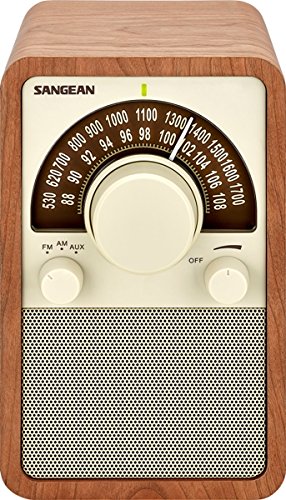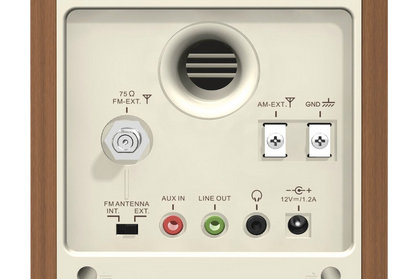 After the Sangean WR-15 received low marks for AM reception in an Amazon review, Bob of Sangean America replied that poor reception is due to the radio’s switching power supply–a design that is federally mandated.
After the Sangean WR-15 received low marks for AM reception in an Amazon review, Bob of Sangean America replied that poor reception is due to the radio’s switching power supply–a design that is federally mandated.
Many thanks to Jeff over at the Herculodge for posting this (click here to read the full response).
It’s a shame the WR-15 can’t accommodate internal batteries as battery operation this would solve the problem.
If I owned the WR-15, I would simply replace the switching type power supply with a regulated power supply.
Looking at the back of the WR-15 (below), it appears it requires 12 volts DC, 1.2 amps and an adapter with a positive center tip. Though I’m judging this only from the image, the plug looks to be a common size. I bet I have a power supply that would fit the bill in my junk drawer.
I bet I have a power supply that would fit the bill in my junk drawer.
Bob, at Sangean America, claims moving the radio at least one foot from the power supply should help. In truth, I believe much of the noise may be conveyed by the power cord itself, though I may be wrong.
It’s a shame Sangean engineers couldn’t compensate somehow for the noisy power supply as it seems this radio was actually marketed to AM radio enthusiasts.

I have the same radio here in Taipei and MV reception is excellent. No noise issues at all. Times I have bought receivers from the US. I always found the power supplies create lots of noise.
The other issue with MV reception is the use of LED and other energy saving bulbs.
For my Kenwood TS-590S transceiver, which I use for SWL listening and DXing, I use a Power Werx SS-30DV switching power supply and it’s totally 100% quiet between 30 kHz and 30 mHz. So properly designed switching power supplies can be quiet.
Good point, Thomas. Most of the switching power supplies used in amateur radio applications are low noise or have a manageable noise signature. It’s the $1 imported ones that are so poorly regulated. That TS-590S is a great transceiver. Bet it does a fine job on the SW bands, too!
-Thomas
Recently, mass LED lamps are applied to home illumination, unfortunately these LED lamps are almost using the swicthing power adaptor, they will interfere the radio seriously, especial on AM band. try to turn on/off home lamps to compare the reception difference with your radio.
Good point, Jelyce. Indeed, the noisiest circuit in my home is the combo of two LED lights with a dimmer. The dimmer is incredibly noisy!
Google the following: “jameco linear wall transformer”, and you’ll find a suitable non-switching replacement. Jameco still has a number of linear transformers in their catalog at reasonable prices. I haven’t bought anything from them in many years but when I dealt with them frequently a number of years back they were always reputable.
Thanks Dan. I apologize for my lack of knowledge on this subject, but I’m looking at Jameco’s Web site, and I see that they offer “AC-to-DC Linear Regulated,” “AC-to-DC Linear Unregulated, and “AC-to-DC Switching” power supplies. Which one do I want? I’ve just purchased a Sangean WR-15.
Is “linear” the opposite of “switching”? Where do “regulated” and “unregulated” come into it?
To complicate matters, it appears that none of Jameco’s linear regulated power supplies meet the requirement of 1.2 amp or greater. Therefore, if I were to purchase one of Jameco’s offerings, it would have to be an linear unregulated model. Would a “linear unregulated” power supply give me any advantage over the stock power supply that comes with the Sangean WR-15?
I appreciate your patience with my questions. If anyone could simply provide a link to a power supply that would work with the WR-15 and is known not to cause interference on the AM band, that would be great! Thanks.
I’ll take that as a “no” then. 🙂
Actually, I don’t really care at this point. My WR-15 performs beautifully for my purpose, which is primarily listening to FM. I can get adequate reception on the one AM station here in my city that I might occasionally want to listen to. Trashing this radio for not being an ideal AM DX’ing tool is missing the point, in my opinion. I figured that if I could get some tips for maximizing the WR-15’s AM reception, then I might as well go ahead and do so. However, I have other radios I could use if I were ever so bored that I wanted to spend time geeking out on the AM band.
Sangean is telling the truth.
I recently purchased a nice used Eton E1 which did not come with a Power Supply.
I have tried a number of Adapters including variable voltage and learned that I need a linear regulated Adapter.
Try to buy a linear, regulated 9 volt 1 amp Adaptor…go now…
And call me in 47.6 days.
I have called a few major suppliers and the Linear Regulated Adapters are not made for USA other than Laboratory Supplies- a larger more expensive device which will not have the pin type connector attached.
One Adapter I purchased was supposed to be linear regulated but was a switching type that was so noisy it completely swamped the AM Signal the Radio was tuned to.
Sounded like Niagara Falls …only much quieter than Niagara Falls.
The Department of Energy mandates these apparently because Linear Regulated Adapters waste Energy into heat and also have a tendency to draw current even when off.
I am hoping to get a Variance for a special type of Adapter for Radio/ Pro Audio use that will be unplugged or shut off via a Power Strip or worse an automatic power strip that shuts off when not under a load preventing the Adapter from drawing power.
Another alternative is a mini lab type Supply with pin connectors sold to Pro Audio/ Ham Users etc.
Yes ..but they have at least one they call linear regulated
9 Volt 1 Amp Adapter that is a very noisy switching type.
Also there a hundreds of Adapters being sold on Ebay and Amazon as ‘Adapter for ____ Radio ‘ for example and
NOT stating that it is aftermarket.
It is an annoying situation for sure.
I did not want to learn about Adapters.
I like my Sanjean PR-D5 radio so much that I bought another, and just received it. I immediately noticed the static on the AM band. Hmmm… Unplugged? No static. On my old adapter? Likewise.
Sanjean included an insert stating “keep your adapter at least 12″ away from the radio”. The plug is 4′ away, ahem.
The gov’t, you say? (Donning tin foil hat.) Well, the gov’t doesn’t much care for AM radio, except for perhaps wanting it (talk) to go away!
I’ve already searched, looking for a replacement adapter, but am off to check Jameco. (Thanks!) I have no idea what I’m doing re: specs. I look and wonder – do they have to be exact? If they vary in voltage and mA, will things not work/blow up?! And yes, this is far more than I wanted to learn about such.
Question, though: will all radios be so affected? This is SO irritating, b/c if I can’t solve the Sanjean problem (x amount of time I will never get back already at this point), I then have to return it and research new radios.
Thanks!
Why bother with expensive retro-looking plastic radios with inferior quality and inferior reception when there are lots of cheap old radios available that are “the real thing”? Especially if you want analog tuning and the looks of an old radio?
Radios from 30 years ago or more needed to have good working mediumwave (and longwave here in Europe), on new radios it’s hit and miss (and mostly miss at that).
According to an earlier review of the WR-15 on Herculodge, the reception on AM is so poor due to the analog DSP tuner that a quieter power supply won’t make that much difference.
http://herculodge.typepad.com/herculodge/2015/04/john-cannot-recommend-the-sangean-wr-15-radio-due-to-subpar-am-and-fm.html
Good point, Gary. Sad such a promising radio is so poorly engineered.
To be fair, that’s not what the article says. The radio appears to have a “channel locking” feature (possibly caused DSP circuitry) that DXers/hobbyists would find annoying, although the average consumer may not. This should only affect reception of weak stations. Stronger stations should come in clearly but it appears this isn’t the case.
The AM reception issue seems to be tied to interference instead (from the power supply), although it would be interesting to see a fresh review after somebody tries a different source of power. Although I like the look of this radio I would likely not be interested in it overall.
Interesting. Last year I bought a rather well regarded SDR, a WinRadio Excalibur. What did it have for a power supply ? A cheap, light weight switcher. Terrible noise producer, and I don’t mean just RF. It made an AUDIBLE high pitch noise. I naturally junked the switcher and just used a conventional supply, solving the issue. But really, for a $900 receiver WinRadio could have done a lot better. Not sure what they were thinking, except to make a bit more profit by using a junk PS. I’m very happy with the radio itself however, which is a fine performer.
That’s interesting, Mark. This must be a recent change. My Excalibur is perhaps 3 years old now and it came with a very nice–and quiet–regulated power supply. Did you contact Radixon about this? Soon, there may be a healthy market for proper regulated power supplies. I think C.Crane has recognized this.
Ridiculous excuse for poor radio design. Not hard to design low noise switchmode power supplies at that current output. But it might cost $3 more in parts. Says more about a company’s engineering ability than anything. Stop blaming the government for encouraging responsible efficient power supply design.
Amen, Bill.
Eee, can it be that the government requires switching supplies? Just bought a widely marketed Alinco top-of-the-line switching supply for my new HF rig, and the thing puts out so many spurs I thought my radio was broken. But the noise is from the power supply. This model includes a knob to adjust the switching frequency. But because the spurs are so frequent, I have to spend more time fiddling to tune away the wheedles and less time hamming and SWLing. Wish I had a conventional supply with that old thing they called a transformer.
You might snag a simple used Radio Shack 12VDC regulated supply. They made them for years and, I believe, cost around $20. I saw dozens of them for sale at the Hamvention flea market last week. I’ve also had success using a 12 VDC gel cell battery with a simple charging circuit–as a bonus, it works when the power goes out!